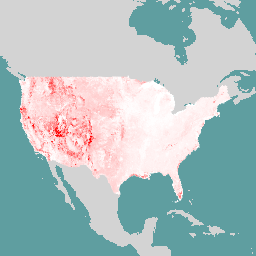
- 데이터 세트 사용 가능 기간
- 2020-12-31T00:00:00Z–2022-12-31T00:00:00Z
- 데이터 세트 제공업체
- USDA 산림청 연구 데이터 보관 파일
- 태그
설명
이 데이터 세트는 다음 조건을 충족하는 미국 내 모든 토지의 산불 위험 구성요소를 보여줍니다. 1) 전반적인 지형(즉, 지형의 모든 픽셀에서 측정 가능) 2) 현장 위험을 나타냄(즉, 지형에서 부정적인 영향이 발생하는 위치의 위험)
USDA Forest Service, Rocky Mountain Research Station, Pyrologix LLC에서 생성한 연간 화재 발생 확률 및 화재 강도의 국가 산불 위험 데이터 세트가 커뮤니티의 산불 위험 데이터의 기반을 형성합니다. LANDFIRE 2020(버전 2.2.0)의 식생 및 야생 연료 데이터는 서로 다르지만 관련이 있는 두 가지 지리 공간 화재 시뮬레이션 시스템의 입력으로 사용되었습니다. 연간 화재 발생 확률은 USFS 지리공간 화재 시뮬레이터 (FSim)를 사용하여 비교적 거친 셀 크기인 270미터 (m)로 생성되었습니다. 번 확률 래스터 데이터는 LANDFIRE 연료 및 식생 데이터의 기본 30m 해상도로 업샘플링되어 데이터를 지역 사회의 위험과 위험을 평가하는 데 더 유용한 미세 해상도로 가져왔습니다. 이 업샘플링 프로세스에서 제공자는 모델링된 연소 확률 값을 LANDFIRE 연료 데이터에 연소 불가능으로 표시된 개발 지역으로도 확산시켰습니다.
화재 발생 확률 래스터는 2020년 말의 지형 조건을 나타냅니다. 화재 강도 특성은 화재 시즌에 발생하는 전체 범위의 날씨 관련 특성을 포괄하는 FlamMap 실행을 수행한 다음 이러한 실행을 이러한 날씨 유형이 발생할 가능성에 따라 다양한 결과로 통합하는 프로세스를 사용하여 30m 해상도로 모델링되었습니다. 화재 강도 모델링 전에 2021년과 2022년에 발생한 연료 교란을 반영하도록 LANDFIRE 2020 데이터가 업데이트되었습니다. 따라서 화재 강도 데이터 세트는 2022년 말의 지형 조건을 나타냅니다.
대역
픽셀 크기
30미터
대역
| 이름 | 단위 | 최소 | 최대 | 픽셀 크기 | 설명 |
|---|---|---|---|---|---|
BP |
0 | 0.14 | 미터 | 연간 화재 발생 확률입니다. |
|
CFL |
피트 | 0 | 861.7 | 미터 | 조건부 화염 길이: 화재가 발생할 경우 최대 확산 방향으로 연소되는 화재의 평균 화염 길이입니다. 산불 강도의 평균 측정값입니다. |
CRPS |
0 | 100 | 미터 | 잠재적 구조물에 대한 조건부 위험: 화재가 발생하고 해당 위치에 주택이 있는 경우 특정 위치의 주택에 대한 화재의 잠재적 결과입니다. |
|
Exposure |
0 | 1 | 미터 | 주택이 산불에 얼마나 노출되는지를 측정한 값입니다. 값 1은 '직접' 노출입니다. 0과 1 사이의 값은 '간접' 노출을 나타내며, 값이 클수록 직접 노출된 영역에 더 가까이 있음을 나타냅니다. |
|
FLEP4 |
0 | 1 | 미터 | 화염 길이 초과 확률 - 4피트: 화재 발생 시 픽셀의 화염 길이가 4피트를 초과할 조건부 확률입니다. 중간에서 높은 산불 강도의 가능성을 나타냅니다. |
|
FLEP8 |
0 | 1 | 미터 | 농장 길이 초과 확률 - 8피트: 화재 발생 시 픽셀의 화염 길이가 8피트를 초과할 조건부 확률입니다. 산불 강도가 높을 가능성을 나타냅니다. |
|
RPS |
0 | 13.2 | 미터 | 잠재적 구조물에 대한 위험: 해당 위치에 집이 있는 경우 집의 상대적 위험입니다. |
|
WHP |
0 | 99.853 | 미터 | 산불 위험 가능성 지수입니다. |
이용약관
이용약관
인용
Scott, Joe H.; Dillon, Gregory K.; Jaffe, Melissa R.; Vogler, Kevin C.; Olszewski, Julia H.; Callahan, Michael N.; Karau, Eva C.; Lazarz, Mitchell T.; Short, Karen C.; Riley, Karin L.; Finney, Mark A.; Grenfell, Isaac C. 2024년 커뮤니티의 산불 위험: 미국의 전반적인 산불 위험 구성요소의 공간 데이터 세트입니다. 2판. Fort Collins, CO: Forest Service Research Data Archive. doi:10.2737/RDS-2020-0016-2
DOI
Earth Engine으로 탐색하기
코드 편집기(JavaScript)
var dataset = ee.ImageCollection('USDA/WRC/v0').mosaic() var cfl = dataset.select('CFL'); var vis = {min: 0, max: 30, palette: ['white', 'red']} Map.addLayer(cfl, vis, 'Conditional Flame Length'); Map.setCenter(-101, 39, 4)
